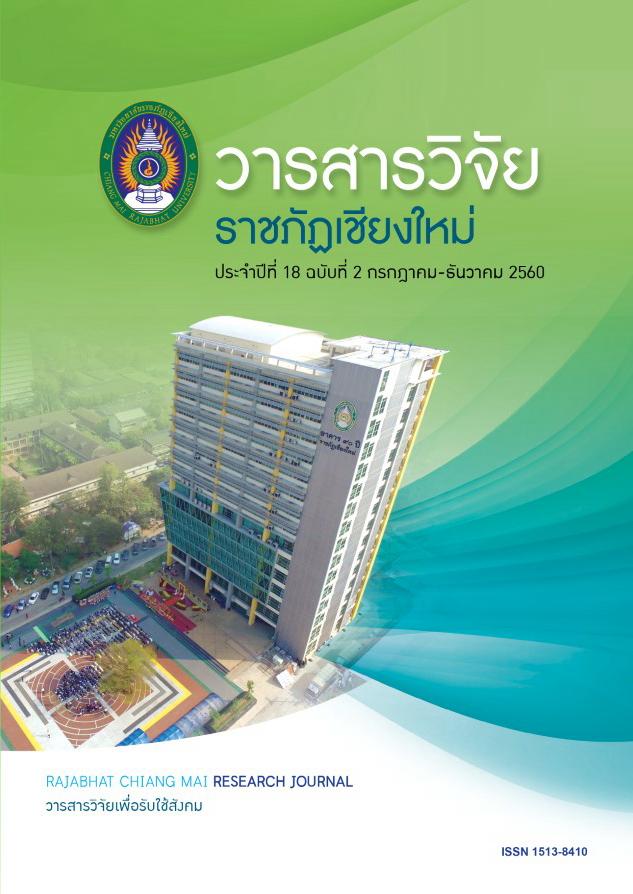The Potential Development of Conciliator in Community Justice: The Case Study of Chompoo Community Justice Center, Saraphi District, Chiang Mai Province
DOI:
https://doi.org/10.14456/rcmrj.2017.209655Keywords:
Community Justice, Conciliator, Conflict Management, ConciliationAbstract
This objective of this research is, to study the problems and the barriers in the potential of community justice conciliators in community justice center and development the potential of community justice conciliators in community justice center, Chompoo sub-district, Saraphi district, Chiang Mai province. In order that, this research is quality of research methodology to be a tool for analyzing, in other words, at first part by collecting information as documentary and the other part from interview people, and meeting the leader group of community, community conciliators, included the test from practice conciliation. By using the framework concept of developing community justice system from the Ministry of Justice that conciliation or conflict management has held to be the main significant mission to run the process of community justice center to be effective.
The results of this research has found, 1) The conciliators at community justice center in sub-district does not prescribe the specific of qualification on the framework of setting and management community justice center that shall be apply to The Principle of Local Administrative Act B.E. 2457 and The Principle of Ministry of Interior in Practice to Conciliation By the Village Committee B.E. 2530 that prescribed to be a duty of villager committee to take conciliation that occurs to the village in civil case and minor offense in criminal case. 2) The potential of conciliators at community justice center in Chompoo sub-district, Saraphi district, Chiang Mai, should get the potential development of conciliators on knowledge of law included the process of conciliation in practice for duty for serve justice to people in community to be more effectiveness. Nevertheless, it is found out that the community justice center is lack from the format of administration management process for serve justice especially on the conciliation for people in community according to the framework at developing community justice from Ministry of Justice.
Downloads
References
กิตติพงษ์ กิตยารักษ์, “การพัฒนาระบบยุติธรรมชุมชนในสังคมไทย.” ใน ยุติธรรมชุมชน: บทบาทการอำนวยความยุติธรรมโดยชุมชนเพื่อชุมชน. หนังสือชุด “ปฏิรูปกระบวนการยุติธรรม” ลำดับที่ 5.กรุงเทพมหานคร: สำนักงานกองทุนสนับสนุนการวิจัย (สกว.), 2550.
จุฑารัตน์ เอื้ออำนวย, “ยุติธรรมชุมชน: ทฤษฎีกระบวนการยุติธรรมภาคประชาชน”, ใน ยุติธรรมชุมชน : บทบาทการอำนวยความยุติธรรมโดยชุมชนเพื่อชุมชน, กิตติพงษ์ กิตยารักษ์, บรรณาธิการ,
กรุงเทพมหานคร: สำนักงานกองทุนสนับสนุนการวิจัย (สกว.), 2550.
ชวน หลีกภัย. 2547. วิธีการระงับข้อพิพาทด้วยการไกล่เกลี่ย. กรุงเทพมหานคร: กระทรวงยุติธรรม.
พรรณยง พุฒิภาษ, “กระบวนการระงับข้อพิพาททางเลือก.” ใน การจัดการความข้ดแย้งกับการไกล่เกลี่ย ข้อพิพาท: ความรู้เบื้องต้นเกี่ยวกับการไกล่เกลี่ยข้อพิพาท, สรวิศ ลิมปรังษี, บรรณาธิการ, พิมพ์ครั้งที่ 2, กรุงเทพมหานคร: สำนักระงับข้อพิพาท สำนักงานศาลยุติธรรม, 2550.
มนตรี ศิลป์มหาบัณฑิต, “การบริหารความขัดแย้ง” ใน การจัดการความขัดแย้งกับการไกล่เกลี่ยข้อพิพาท: ความรู้เบื้องต้นเกี่ยวกับการไกล่เกลี่ยข้อพิพาท, สรวิศ ลิมปรังษี, บรรณาธิการ, พิมพ์ครั้งที่ 2, กรุงเทพมหานคร: สำนักระงับข้อพิพาท สำนักงานศาลยุติธรรม, 2550.
ประธาน วัฒนวาณิชย์, “ยุติธรรมชุมชน: การศึกษาบทบาทของงานยุติธรรมชุมชนในการป้องกัน อาชญากรรม และการแก้ไขฟื้นฟูผู้กระทำความผิด.” ใน ยุติธรรมชุมชน: บทบาทการอำนวยความ ยุติธรรมโดยชุมชนเพื่อชุมชน, กิตติพงษ์ กิตยารักษ์, บรรณาธิการ, กรุงเทพมหานคร: สำนักงานกองทุน สนับสนุนการวิจัย (สกว.), 2550.
ปัอมฤดี กุมพันธ์. 2557. การไกล่เกลี่ยข้อพิพาทก่อนฟ้องในศาลส่วนคดีนักท่องเที่ยว. วิทยานิพนธ์ นิติศาสตรมหาบัณฑิต คณะนิติศาสตร์ สถาบันพัฒนบริหารศาสตร์.
สรวิศ ลิมปรังษี, “ความขัดแย้งและวิธีการระงับข้อพิพาททางเลือก” ใน การจัดการความขัดแย้งกับการไกล่เกลี่ยข้อพิพาท:ความรู้เบื้องต้นเกี่ยวกับการไกล่เกลี่ยข้อพิพาท, พิมพ์ครั้งที่ 2, กรุงเทพมหานคร:สำนักระงับ ข้อพิพาท สำนักงานศาลยุติธรรม, 2550.
อิทธิพล ศรีเสาวลักษณ์, “แนวคิดเกี่ยวกับกฎหมายเพื่อเสริมสร้างความเข้มแข็งของชุมชน.”ใน การจัดการ ความขัดแย้งกับการไกล่เกลี่ยข้อพิพาท:ความรู้เบื้องต้นเกี่ยวกับการไกล่เกลี่ยข้อพิพาท, สรวิศ ลิม ปรังษี, บรรณาธิการ, พิมพ์ครั้งที่ 2, กรุงเทพมหานคร: สำนักระงับข้อพิพาท สำนักงานศาลยุติธรรม, 2550.
Braithwaite, J., 2002, Restorative Justice and Responsive Regulation, New York: Oxford University Press.
Brandell, J.R., & Perlman, F.T., 1997, “Psychoanalytic Theory.” In Brandell, J.R., (Ed.), Theory and Practice in Clinical Social Work, New York: The Free Press.
Porter, M.E., 1985, The Competitive Advantage: Creating and Sustaining Superior Performance, New York: The Free Press.
Justice Reparatrice en Ligne, 2001, UN Acts to Advance Restorative Justice (Online), Available: http://www.justicereparatrice.org/www.restorativejustice.org/editions/2001/July01/UNactstoadvancerestorativejustice. (14 August 2017)
Sourdin, T., 2014, Alternative Dispute Resolution (ADR) Principles: From Negotiation to Mediation (Online), Available: http://ir.nul.nagoya-.ac.jp/jspui/bitstream/2237/20943/1/90Tania%20Sourdin.pdf. (14 August 2017)
Downloads
Published
How to Cite
Issue
Section
License
1. Articles, information, content, images, etc published in the “Community and Social Development Journal” are copyrighted by the Community and Social Development Journal, Chiang Mai Rajabhat University. In order to properly distribute the articles through print and electronic media, the authors still hold the copyright for the published articles under the Creative Commons Attribution (CC BY) license, which allows the re-distribution of the articles in other sources. References must be made to the articles in the journal. The authors are responsible for requesting permission to reproduce copyrighted content from other sources.
2. The content of the articles appearing in the journal is the direct responsibility of the article authors. The editorial board of the journal does not necessarily agree with or share any responsibility.














